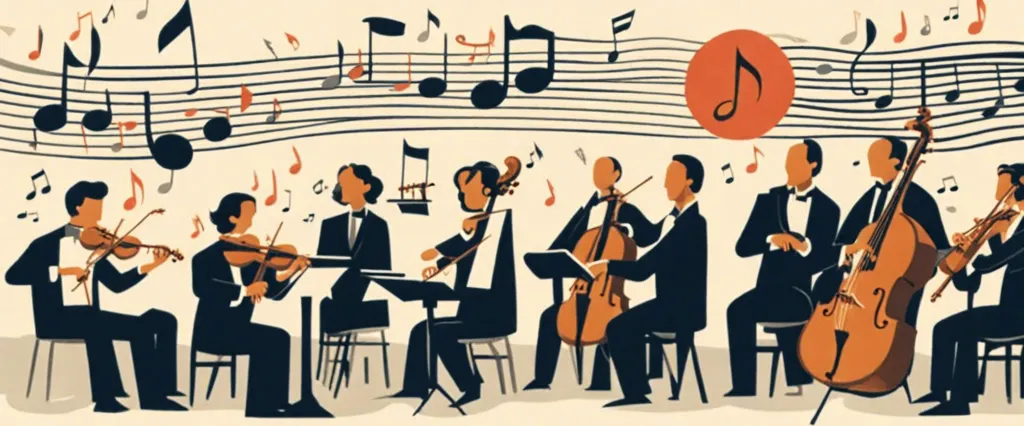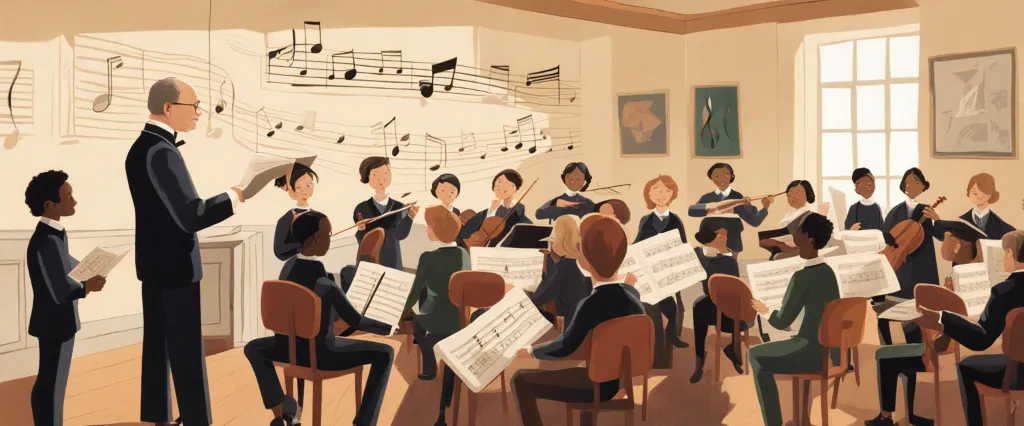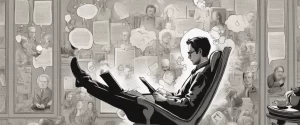——What to Listen for in Music by Aaron Copland & The Art Of Game Design by Jesse Schell

In the vast universe of human creations, two art forms seem to hold a unique power to captivate, inspire, and transport us beyond the boundaries of our existence: music and games. Both possess an undeniable ability to evoke emotions, manipulate our perceptions, and immerse us in rich and enchanting experiences. Yet, while music has been crafted for centuries and games have emerged as a distinctive form of entertainment in recent decades, their underlying principles and artistic elements remain intriguingly analogous.
In this comparative study, we delve into the realms of two seemingly disparate masterpieces: “What to Listen for in Music” by Aaron Copland and “The Art of Game Design” by Jesse Schell. Written in separate epochs and exploring distinct realms of artistic expression, these two books share an unyielding dedication to unraveling the inherent secrets of their respective art forms. As we embark on this intellectual journey, we will discover surprising parallels between the world of symphonies and the realm of interactive adventures.
Aaron Copland, one of America’s most celebrated composers, eloquently guides us through the enchanting labyrinth of music in his seminal work “What to Listen for in Music.” Originally published in 1939, Copland’s treatise aimed to demystify the potential esotericism of music for the average listener. With remarkable depth and clarity, he articulates the essential elements of musical language, from melody and rhythm to dynamics and structure. Copland’s words resonate as an invitation for us to engage with music more deeply, urging us to grasp its inner workings and appreciate its profound emotional impact.
On the other side of the artistic spectrum, we encounter Jesse Schell’s “The Art of Game Design,” an opus published in 2008 that expands our understanding of games beyond mere entertainment. Schell, a visionary game designer and educator, invites us into a vibrant world where games become more than playful pastimes, emerging as powerful tools for expression, creativity, and storytelling. By unraveling the intricate layers of game design, Schell unveils the artistry behind crafting compelling experiences. From mechanics and dynamics to aesthetics and technology, he connects the dots between game design and human psychology, underscoring the transformative power of interactive worlds.
As we examine these two works side by side, we find ourselves at the crossroads where the harmonies of music converge with the dynamics of game design. Both Copland and Schell venture to unravel the invisible threads that bind their respective artistic realms, peeling back the layers to reveal the underlying principles and techniques that shape and elevate these forms of expression. From the composition of melodies to the design of engaging gameplay loops, it becomes evident that music and games share a common ground in the realm of human artistry.
Join us now as we embark on a profound exploration of artistic expression, where symphonies and game worlds interweave. Through this comparative study of “What to Listen for in Music” and “The Art of Game Design,” we aim to uncover the tapestry that connects these seemingly disparate realms, seeking new insights into the human experience and the power of creativity in shaping the world around us.
Brief Summary of Two Books
What to Listen for in Music by Aaron Copland
What to Listen for in Music by Aaron Copland is a concise and comprehensive guide that aims to educate readers on how to actively and critically listen to music. Copland, an esteemed composer and conductor, presents his insights and expertise in a clear and accessible manner, making this book suitable for both musicians and non-musicians alike.
The book begins by addressing the fundamental question of what music is, exploring its emotional impact and the importance of understanding its structure. Copland explains key musical elements such as melody, rhythm, harmony, and tone color, analyzing their role in creating meaning and expression within a composition.
Additionally, Copland delves into the various forms and structures found in music, including the sonata and symphony. He elucidates the relationships between themes and motifs, demonstrating how composers develop and manipulate these musical ideas throughout a piece.
Another significant aspect of the book is Copland’s examination of different musical styles and genres. He discusses classical music, jazz, and folk music, emphasizing the unique characteristics and historical context of each. Copland urges readers to appreciate and respect the diverse range of musical expressions that exist.
Throughout the book, Copland provides numerous musical examples, encouraging readers to actively listen to specific compositions and observe the concepts he explores. He offers valuable guidance on how to approach different types of music, providing listeners with the tools to engage more deeply with the art form.
Overall, What to Listen for in Music is an invaluable resource for anyone seeking to enhance their understanding and appreciation of music. Copland’s expertise and passion shine through in this insightful guide, allowing readers to develop a more discerning ear and a greater appreciation for the intricacies of musical composition.
The Art Of Game Design by Jesse Schell
“The Art of Game Design” by Jesse Schell is a comprehensive guide that explores the world of game design and offers insights, principles, and strategies for creating compelling games. The book is divided into various chapters, each focusing on a specific aspect of game design.
Schell begins by emphasizing the importance of understanding the players and their motivations to create engaging experiences. He discusses the psychology and different types of players, as well as the crucial role emotions play in games. He also encourages designers to take inspiration from various sources, including aesthetics and storytelling techniques, to create unique and immersive game worlds.
The book delves into the mechanics of game design, discussing the importance of rules, feedback, and balanced systems to create an enjoyable gameplay experience. It also explores the concept of “flow” and how to create a rhythm in gameplay that keeps players engaged.
Schell then explores the narrative and storytelling aspects of game design, discussing the different types of narrative structures, character development, and how to create meaningful choices and consequences.
The author further delves into the process of designing game levels and environments, discussing the importance of visual design, audio, and user interfaces to enhance the player’s experience. He provides techniques to create memorable and aesthetically pleasing game worlds.
In addition to the design aspects, Schell also discusses the business and ethical considerations of game design. He explores topics such as monetization strategies, marketing, and the social impact of games.
Overall, “The Art of Game Design” offers a comprehensive overview of various facets of game design, providing valuable insights and practical advice for aspiring game designers or anyone interested in understanding the art of creating immersive and engaging games.
Comparison between Two Books

Similarities in Creativity
Both “What to Listen for in Music” by Aaron Copland and “The Art of Game Design” by Jesse Schell explore the concept of creativity from different perspectives, one focused on music and the other on game design. Despite the different mediums, there are several similarities regarding creativity in these books:
1. Understanding the creative process: Both authors emphasize the importance of understanding and appreciating the creative process. Copland highlights the various elements that contribute to the creation of a musical piece, such as melody, rhythm, and harmony, while Schell delves into the iterative design process involved in creating games. Both authors advocate for a deep understanding of the craft and the ability to manipulate elements effectively.
2. The importance of inspiration: Both books stress the significance of inspiration in the creative process. Copland discusses how various sources, including nature, literature, and other composers’ works, can serve as stimuli for musical composition. Similarly, Schell emphasizes the need for game designers to draw inspiration from a variety of sources, such as literature, films, and personal experiences, to create captivating and unique gaming experiences.
3. Balancing creativity and technicality: Both authors acknowledge the importance of balancing creativity with technical skills. Copland argues that a musician must possess technical mastery of their instrument to fully express their creative ideas effectively. Schell emphasizes the need for game designers to have a solid understanding of programming, mechanics, and other technical aspects to bring their creative visions to life.
4. Iterative nature of creativity: Both books highlight the iterative nature of the creative process. Copland discusses how composers revise and refine their work multiple times, experimenting with different musical ideas to produce the desired result. Similarly, Schell emphasizes the importance of iterating and playtesting game designs to enhance their quality and appeal.
5. The audience’s role in creativity: Both authors emphasize the importance of considering the audience in the creative process. Copland argues that a composer must strike a balance between pushing artistic boundaries and creating something that resonates with the audience. Schell states that game designers should always consider the player’s experience and ensure their creations engage and entertain the intended audience.
In summary, while “What to Listen for in Music” and “The Art of Game Design” explore creativity in different artistic mediums, they share key similarities regarding the understanding of the creative process, the role of inspiration, the need for technical skills, the iterative nature of creativity, and the audience’s importance in the creative process.
Divergences in Creativity
The book “What to Listen for in Music” by Aaron Copland and “The Art of Game Design” by Jesse Schell offer divergent perspectives on creativity in their respective fields.
In “What to Listen for in Music,” Copland focuses on the appreciation and understanding of classical music. He emphasizes the importance of developing an individual’s ability to actively listen and engage with music. Copland believes that creativity in music stems from a deep understanding of musical structures and the ability to recognize patterns and elements that make a piece unique. Through his analysis and explanations, he aims to guide readers in appreciating the complexities of music and encourages them to actively participate in its creation by actively listening.
On the other hand, in “The Art of Game Design,” Schell takes a broader approach to creativity, specifically within the realm of video game design. He emphasizes the importance of embracing creativity in all aspects of game development, from the initial concept to the final execution. Schell encourages game designers to think outside the box, experiment with new ideas, and challenge established conventions in order to create engaging and innovative game experiences. Unlike Copland’s focus on understanding musical structures, Schell stresses the importance of breaking boundaries and pushing the limits of creativity in game design.
The divergence in the books’ perspectives on creativity lies in their focus and approach. Copland’s book centers mainly on developing an understanding of existing musical structures, recognizing patterns, and appreciating the intricacies of classical music. In contrast, Schell’s book fosters a mindset of exploration, encouraging game designers to think freely, experiment, and challenge traditional game design principles. While Copland’s approach focuses on building a foundation of knowledge and honing analytical skills, Schell’s approach encourages the embracing of risk-taking and the incorporation of new and unconventional ideas.
In summary, “What to Listen for in Music” and “The Art of Game Design” offer divergent insights into creativity within their respective fields. While Copland’s book focuses on the understanding and appreciation of classical music, Schell’s book encourages game designers to push boundaries and think innovatively. The divergence lies in their approaches, with Copland emphasizing understanding and analysis and Schell emphasizing experimentation and breaking conventions.

Conclusion
Both “What to Listen for in Music” by Aaron Copland and “The Art of Game Design” by Jesse Schell are highly regarded books in their respective fields. The choice between the two ultimately depends on your personal interests and what you hope to gain from reading.
If you have a passion for music and want to develop a deeper understanding of it, then “What to Listen for in Music” is a highly recommended read. Copland, a renowned American composer, provides insights into the different elements of music and offers guidance on how to fully appreciate and understand the complexities of various musical styles. This book can be particularly beneficial if you are an aspiring musician or if you simply want to enhance your listening experience.
On the other hand, if you are interested in game design or the broader concept of designing interactive experiences, “The Art of Game Design” may be the more suitable choice. Schell, an experienced game designer, explores the principles and techniques behind successful game design. This book delves into various aspects such as storytelling, mechanics, aesthetics, and player psychology, providing valuable insights and practical advice for those looking to create their own games or understand the intricacies of the medium.
In summary, both books are highly respected in their respective domains, but the more worthy read depends on your personal interests and the specific knowledge or skills you are seeking to gain.


